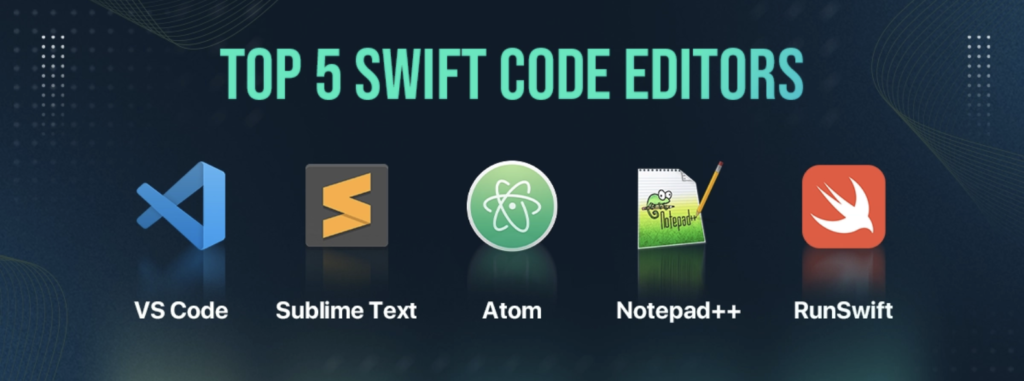
The world of Swift coding is rich with choices for iOS app developers. There are many IDEs designed to enhance Swift programming. Finding the best Swift IDE is key for creating strong applications for Apple’s wide range of products. A top-notch Swift IDE makes coding better. It includes futures like generics and protocol extensions. It also has key safety features such as managing memory and checking for errors that matter a lot for app stability and performance on the latest devices.
Swift Playgrounds has changed how beginners learn Swift coding. It’s a fun and interactive way to get to know the language. For those with more experience, Swift’s ability to work well with Objective-C and C++ boosts project quality. It encourages innovation in the iOS app development world1.
Key Takeaways
- Choosing the best Swift IDE is crucial for effective and secure iOS app-making.
- Generics, safety features, and clear code-writing improve performance on new hardware.
- Xcode’s Swift Playgrounds is a fun educational tool for new coders.
- Swift shows its power by working with various coding languages in one project.
- Free resources make Swift a great starting point for beginners.
The Significance of the Right Swift IDE for Pro Developers
For developers, picking the best Swift IDE is crucial in today’s tough market where Swift is a must-have
Thanks to Swift’s power and flexibility, we’ve seen amazing apps. Zoey Vu’s “Birds of a Feather” won awards. Alexander’s “Just Cook” took just two weeks to develop. And by age 18, Jia Chen had made six App Store apps. Vega’s “Misión Colibrí” shows how Swift can lead big projects
Swift has grown a lot since its 2014 debut, reaching Swift 5.10. It’s gotten better at being efficient and stable, tackling data races and concurrency easily
Streamlining Development with Advanced Features
Today’s Swift IDEs boost efficiency with cool features like local build automation. This cuts down the time to go live significantly
The Impact of IDE Choice on Development Productivity
Picking the right IDE boosts productivity a lot. Swift IDEs offer refactoring support, making it easier for developers to tweak and enhance their codes.
Comparison Swift IDEs Against Basic Text Editors
Swift IDEs do more than basic text editors. They have compiling, debugging, and testing in one place. This shows why the right tools are key for professional Swift development.
Using advanced Swift IDE features means more than just coding. It’s about joining a world that pushes for creativity and top-notch results.
| Swift IDE | Refactoring Support | Local Build Automation | Special Features |
|---|---|---|---|
| Xcode | Extensive | Integrated | Exclusive to Apple platforms, Interface Builder |
| Visual Studio Code | Available with extensions | Configurable | Cross-platform, Live Share |
| AppCode | Robust | Integrated | Smart Code Navigation, JetBrains toolkit |
With Swift’s role growing in tech, choosing a Swift IDE matters a lot. It’s vital for making complex, new, and successful apps.
Understanding Swift IDEs Versus Code Editors
In the world of software creation, especially for Apple devices, choosing between a Swift Code Editor and a Swift IDE is crucial. This choice impacts how well and fast you can create apps. Swift is popular for its straightforward syntax. It is mainly used in Xcode to develop applications for iOS, macOS, watchOS, and tvOS. Swift IDEs come with extra features like compiling, debugging, and running codes. These features are beyond what simple code editors offer, making Swift coding more efficient.
Deciding between a Swift code editor and an IDE involves many factors. Companies must think about the available Swift programmers, which are currently few due to the language’s novelty. The advanced features of Swift also require tools that help new programmers learn quickly. IDEs provide a lot of help with their extensive tutorials, examples, and project templates.
Swift’s interoperability with Objective-C allows for a blend of old and new codebases. However, choosing the right tools for this mix is tough because some third-party tools don’t work well with Swift IDEs. This choice is important for team collaboration and keeping development methods uniform4. Cloud-based IDEs like Nitrous and Cloud9 IDE offer great access and flexibility. They broaden the options for selecting a development environment that fits different project requirements.
Swift is open-source but doesn’t support older iOS versions. This issue means Swift developers often have to update their code for newer versions. A strong Swift IDE can make this task easier. So, when choosing between a code editor and an IDE, think about the project’s future and its needs.
“The best tools are those that not only address current requirements but are also sustainable through future advancements in software development.”
Even the best Swift IDE cannot solve all problems related to Swift’s poor third-party support and tough learning curve. A great IDE, like Visual Studio or Xcode, can make work quicker and smoother. However, it’s up to the Swift development company to pick the right tools. These tools must match their project’s goals and the skills of their developers.
Best Swift IDE: Evaluating the Most Effective Solutions
Finding the top Swift IDE is vital for developers aiming for high achievement in Swift coding. These tools are much more than basic text editors. Each one features different functions that enhance work and project outcomes. Looking for alternatives to Xcode or checking out new tools, the right IDE can make a huge difference.
Swift shines as a programming language because it builds on the newest tech and Apple’s wide experience5. Its clear syntax, like named parameters, makes APIs easy to read and maintain. We’ll look at how top Swift IDEs use Swift’s strong points to create a great development environment.
Breakdown of Features in Best Swift IDEs
Top Swift IDEs offer features crucial for today’s developers. They manage memory automatically and simplify concurrent coding to minimize errors. These IDEs help developers easily use Swift’s advanced features, like generics and protocol extensions. Thanks to integrated LLVM compiler technology, they ensure Swift code runs fast on the latest devices.
Apple’s Swift works on many platforms, including Linux and Windows, which makes choosing an IDE that supports all platforms important. IDEs that help with easy debugging and testing thanks to Swift’s REPL environment make development smoother.
User Interface Aesthetics and Workflow Integration
The look and feel of an IDE is important. A good user interface and workflow integration boost productivity. Xcode, for example, has a sleek design perfect for Apple’s ecosystem, which enhances work on iOS and macOS projects. Meanwhile, Visual Studio Code allows for heavy customization and has a vast library of extensions, making it easier to fit any project need.
Cost Analysis and Open-Source vs. Proprietary
Cost is a big factor in choosing an IDE. It’s about deciding between free, customizable open-source IDEs and paid, feature-rich proprietary ones. Open-source IDEs, like Visual Studio Code, provide great flexibility for customization. On the other hand, proprietary IDEs, such as Xcode, offer specific features for Apple development but are less flexible due to their closed nature. The choice should be based on project needs, team skills, and development goals.
As Swift grows with new features for different tasks, the best Swift IDEs are those that keep up and even lead in Swift programming capabilities. When selecting, consider the IDE’s features, design, cost, and whether it’s open or closed. This guides the search for the most useful Swift development tools.
Top Swift Development Tools for Cross-Platform Coding
In software development, Swift tools stand out for their efficiency and scale. Cross-platform IDEs like Visual Studio Code work well across macOS, Linux, and Windows. This versatility makes it a top choice for Linux and Windows developers. Before, Xcode was mainly used for Swift on Apple devices. Now, developers focus more on tools that work everywhere.
Cross-Compatibility and Non-macOS Development
For those coding on Windows or outside macOS, certain Swift IDEs ensure smooth integration. CocoaPods, for integrating third-party code, supports over 1.5 million apps. It shows the community’s need for tools that ease development on various platforms.
Considering the Swift Programming Environment
React Native is known for its speedy performance, making cross-platform apps that feel like native ones. Then there’s Parse, used by big names like Adobe and BMW, offering essential backend services to enhance mobile apps.
Support and Community Around Swift IDEs
The success of a Swift IDE lies in the support and community around it. Take Firebase by Google, offering extensive backend services to developers. Strong tools together with community support are crucial, as seen in articles like 9 Must-Have iOS Developer Tools to Keep an Eye on in 2023.
TestFlight has been vital for iOS beta testing, supporting up to 100 testers. Also, Fastlane automates tasks from build to deployment, underscoring the value of workflow tools in development.
Conclusion
Exploring top Swift IDEs has shown us how powerful these tools can be. With the growth of Swift since 2014, iOS app development is changing fast. Apple’s CEO, Tim Cook, believes Swift will soon be the main language for making apps. This change is big for developers.
Choosing the right Swift IDE is key. Good Swift IDEs boost productivity and help with project management. They are easy to use, work well on Apple devices, and show Swift’s goals: to be clean, safe, and fast. Being open-source, Swift also helps create a strong community. This opens up many new chances for working together.
What matters most is how Swift IDEs meet developers’ complex needs. They simplify code work and make apps more stable. Using the right IDEs means tapping into Swift’s rich features, aiming to build powerful new apps. As Swift grows more central, adding top Swift IDEs into the workflow is crucial for success.
FAQ
What are some of the best Swift IDEs for efficient iOS app development?
Xcode is the go-to IDE for iOS app development because it works well with Apple’s system. AppCode stands out for its strong refactoring features. Visual Studio Code is great for its customization options through extensions.
How do advanced IDE features streamline the development process for professionals?
Advanced features in Swift IDEs, like auto code editing and smart code completion, make work faster. They also have tools for debugging and automating builds. This helps developers write and test code more easily.
In what ways do Swift IDEs impact a developer’s productivity?
Swift IDEs boost productivity by offering tools for checking code, spotting errors, and managing versions. They also automate many coding tasks. This lets developers focus on making innovative features and quality code.
How do Swift IDEs differ from basic text editors?
Swift IDEs are more than basic text editors because they have tools for compiling and debugging. They also help with version control and project management. These are key for making complex apps in one place.
What should I consider when deciding between a Swift code editor and a Swift IDE?
Think about if you need just a coding tool or a full development environment with features like debugging. Consider if you want something that works on different platforms and matches your workflow.
How do the features of the best Swift IDEs facilitate iOS development?
The top Swift IDEs have features like advanced debugging, build automation, and smart code prediction. They also work well with version control systems. These features make iOS development smoother and more efficient.
Why is the user interface aesthetic important in a Swift IDE?
A clean and simple user interface in a Swift IDE makes it easier for developers to use its tools. This improves productivity and makes the development experience better.
How does the cost factor into choosing between open-source and proprietary Swift IDEs?
Your project’s budget can affect your choice. Open-source Swift IDEs are usually free and customizable. Proprietary IDEs might offer more features and support but cost more.
What are the benefits of cross-platform Swift IDEs?
Cross-platform Swift IDEs let developers work in the same environment on different systems. This is great for teams using macOS, Linux, and Windows.
When considering a Swift IDE for non-macOS platforms, what additional setups might be necessary?
Using Swift on non-macOS platforms may need extra tools to support Swift’s compilation and execution. Unlike Xcode for macOS, which supports Swift natively.
How can the community support impact the choice of a Swift IDE?
A strong community for a Swift IDE offers great resources like documentation and forums. These can help solve tricky problems or learn new Swift skills.
Future App Studios is an award-winning software development & outsourcing company. Our team of experts is ready to craft the solution your company needs.










